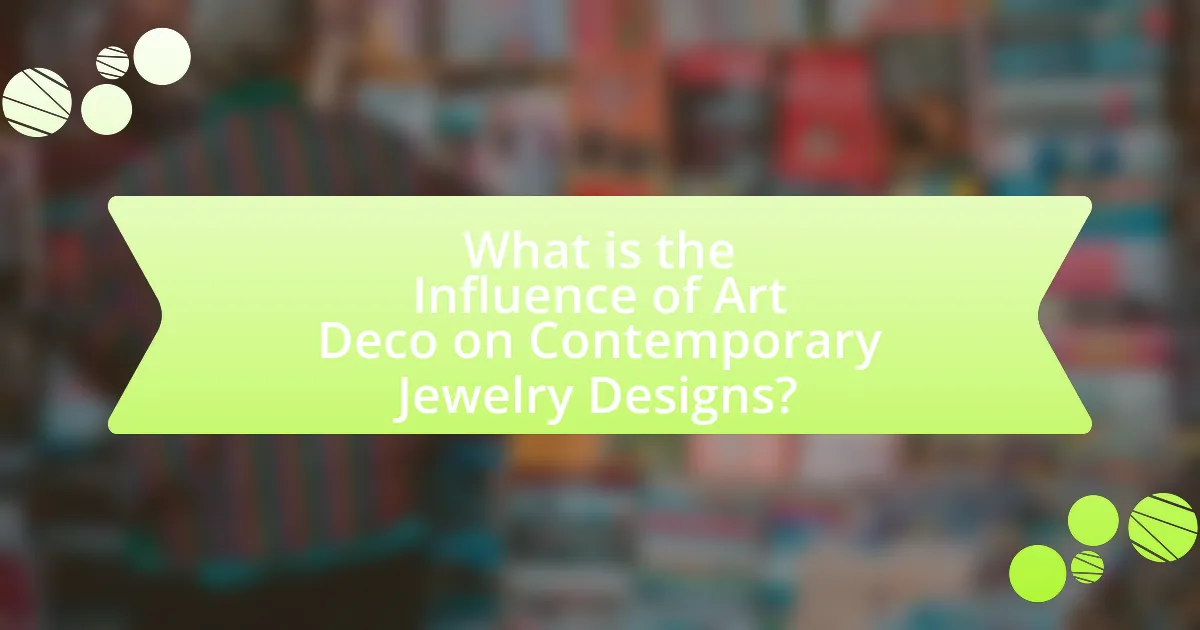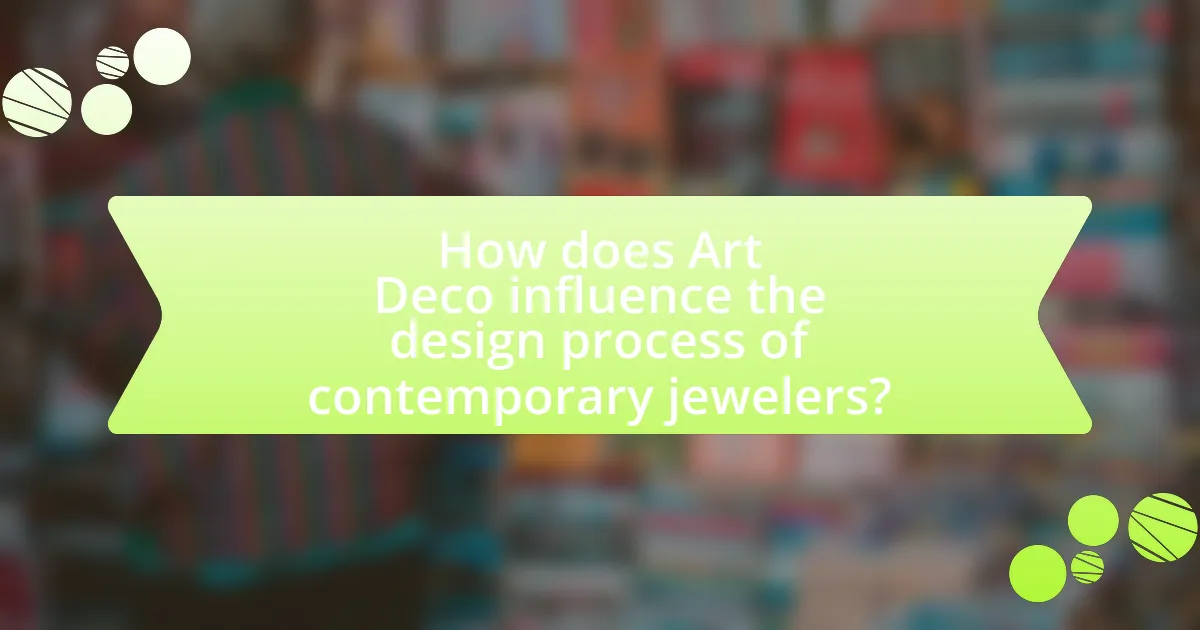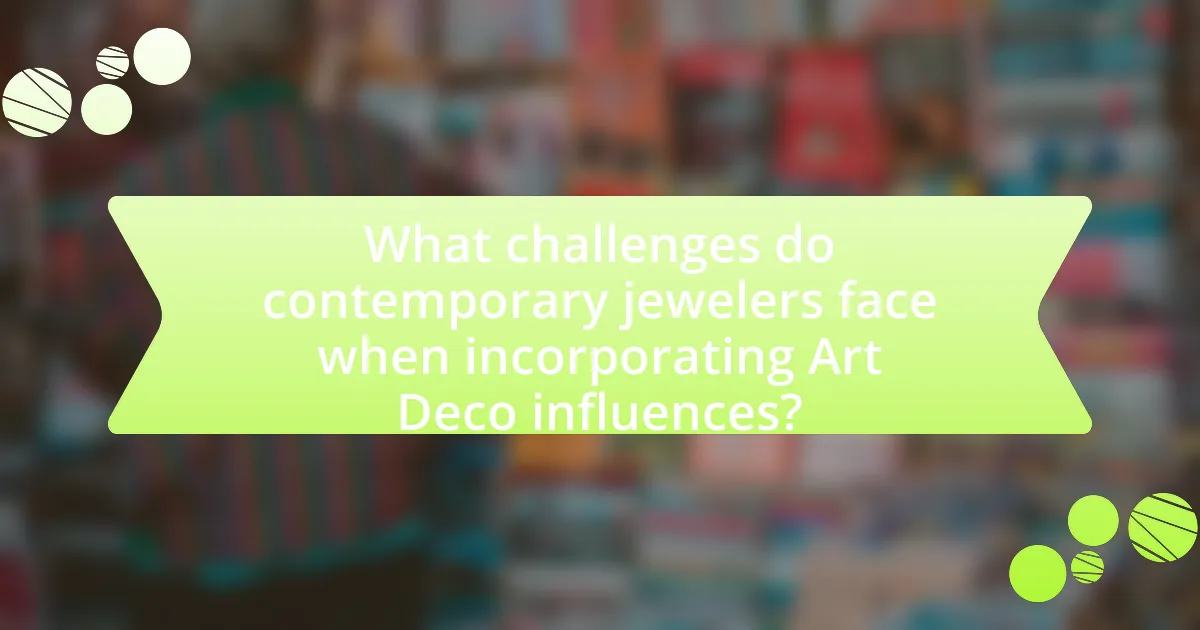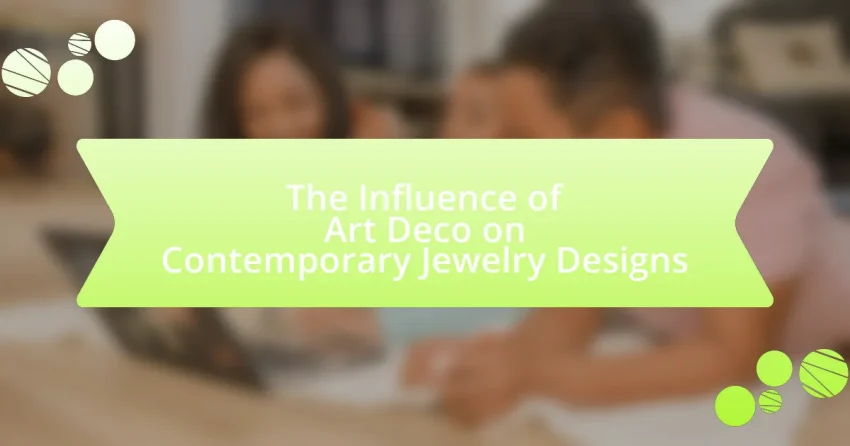The article examines the significant influence of the Art Deco movement on contemporary jewelry designs, highlighting its defining characteristics such as geometric shapes, bold colors, and luxurious materials. It traces the emergence of Art Deco in the early 20th century and its lasting impact on modern jewelry, including the revival of vintage pieces and the incorporation of traditional craftsmanship techniques. Key elements like symmetry, intricate patterns, and the use of materials such as platinum and colored gemstones are discussed, along with the challenges contemporary jewelers face in balancing historical authenticity with modern aesthetics. The article also explores consumer perceptions of Art Deco-inspired jewelry and current market trends that reflect a renewed interest in this iconic design style.

What is the Influence of Art Deco on Contemporary Jewelry Designs?
Art Deco significantly influences contemporary jewelry designs through its emphasis on geometric shapes, bold colors, and luxurious materials. This design movement, which flourished in the 1920s and 1930s, introduced a modern aesthetic characterized by streamlined forms and intricate detailing. Contemporary jewelers often incorporate Art Deco elements such as symmetrical patterns and the use of enamel, diamonds, and colored gemstones, reflecting the era’s opulence. For instance, the revival of vintage Art Deco pieces in modern collections showcases how these historical designs continue to inspire current trends, emphasizing the enduring appeal of Art Deco’s distinctive style.
How did Art Deco emerge as a significant design movement?
Art Deco emerged as a significant design movement in the early 20th century, primarily during the 1920s and 1930s, characterized by its bold geometric shapes, vibrant colors, and luxurious materials. This movement gained prominence following World War I, as societies sought to break away from traditional styles and embrace modernity, reflecting the technological advancements and cultural shifts of the time. The 1925 Exposition Internationale des Arts Décoratifs et Industriels Modernes in Paris showcased Art Deco’s aesthetic, solidifying its influence in architecture, fashion, and decorative arts. The movement’s emphasis on craftsmanship and opulence resonated with the affluent classes, leading to its widespread adoption in various design fields, including jewelry, where it inspired intricate designs and innovative use of materials.
What are the defining characteristics of Art Deco style?
Art Deco style is characterized by its bold geometric shapes, vibrant colors, and luxurious materials. This design movement, which emerged in the 1920s and 1930s, emphasizes symmetry and streamlined forms, often incorporating motifs inspired by nature, technology, and ancient cultures. The use of materials such as chrome, glass, and exotic woods, along with intricate detailing, further defines the aesthetic. Notably, Art Deco’s influence can be seen in architecture, fashion, and jewelry, where its distinctive style continues to inspire contemporary designs.
How did historical events shape the Art Deco movement?
Historical events significantly shaped the Art Deco movement by influencing its aesthetic and thematic elements. The aftermath of World War I brought a desire for modernity and optimism, leading to a break from traditional styles and the embrace of new materials and technologies. The 1925 Exposition Internationale des Arts Décoratifs et Industriels Modernes in Paris showcased the movement’s principles, emphasizing luxury, geometric forms, and vibrant colors, which reflected the economic prosperity of the Roaring Twenties. Additionally, the rise of industrialization and advancements in manufacturing allowed for mass production of Art Deco designs, making them accessible to a broader audience. These historical contexts provided the foundation for Art Deco’s distinctive characteristics, which continue to influence contemporary jewelry designs today.
What are the key elements of Art Deco that influence contemporary jewelry?
The key elements of Art Deco that influence contemporary jewelry include geometric shapes, bold colors, and the use of luxurious materials. Geometric shapes, characterized by clean lines and symmetrical designs, are prevalent in contemporary pieces, reflecting the Art Deco emphasis on modernity and elegance. Bold colors, often achieved through the use of enamel and vibrant gemstones, echo the Art Deco palette that favored striking contrasts. Additionally, the incorporation of luxurious materials such as platinum and diamonds in Art Deco jewelry continues to inspire contemporary designers, who seek to evoke a sense of opulence and sophistication in their creations. These elements collectively demonstrate the lasting impact of Art Deco aesthetics on modern jewelry design.
How do geometric shapes play a role in contemporary jewelry designs?
Geometric shapes are fundamental in contemporary jewelry designs, reflecting the influence of Art Deco aesthetics. These shapes, characterized by clean lines and symmetrical forms, create visually striking pieces that emphasize modernity and minimalism. For instance, designers often utilize triangles, circles, and squares to construct bold, architectural jewelry that resonates with the Art Deco movement’s emphasis on geometry and abstraction. This approach not only enhances the visual appeal but also allows for innovative use of materials and techniques, such as 3D printing and laser cutting, which further exemplify the integration of geometric principles in contemporary design.
What materials and colors are inspired by Art Deco in modern jewelry?
Modern jewelry inspired by Art Deco primarily utilizes materials such as platinum, gold, and gemstones like diamonds, emeralds, and sapphires. These materials reflect the luxurious and geometric aesthetic characteristic of the Art Deco movement, which flourished in the 1920s and 1930s. The colors commonly associated with Art Deco jewelry include bold hues like deep blue, green, and red, often contrasted with black and white elements to create striking visual effects. This color palette and material selection are rooted in the Art Deco emphasis on opulence and symmetry, as seen in historical pieces from that era, which continue to influence contemporary designs.
Why is the influence of Art Deco relevant in today’s jewelry market?
The influence of Art Deco is relevant in today’s jewelry market because it embodies a timeless aesthetic characterized by geometric shapes, bold colors, and luxurious materials. This design style, which emerged in the 1920s and 1930s, continues to inspire contemporary jewelers who seek to blend vintage elegance with modern sensibilities. For instance, the resurgence of Art Deco motifs in current collections reflects consumer demand for unique, statement pieces that evoke a sense of nostalgia while maintaining contemporary appeal. Additionally, the Art Deco period is associated with high craftsmanship and quality, which resonates with today’s buyers who prioritize artisanal and bespoke jewelry.
How do consumers perceive Art Deco-inspired jewelry?
Consumers perceive Art Deco-inspired jewelry as a symbol of elegance and sophistication, often associating it with luxury and timeless style. This perception is rooted in the historical context of the Art Deco movement, which emerged in the 1920s and 1930s, characterized by bold geometric shapes, vibrant colors, and intricate craftsmanship. Research indicates that contemporary consumers are drawn to Art Deco designs for their unique aesthetic appeal and the nostalgia they evoke, reflecting a desire for individuality and a connection to a glamorous past. Additionally, a survey conducted by the Jewelry Consumer Opinion Council found that 68% of respondents view Art Deco-inspired pieces as desirable investments, further validating their positive perception in the market.
What trends in contemporary jewelry reflect Art Deco influences?
Contemporary jewelry trends that reflect Art Deco influences include geometric shapes, bold colors, and intricate detailing. These elements are characteristic of the Art Deco movement, which emphasized symmetry and modernity in design. For instance, the use of angular forms and chevrons in rings and necklaces mirrors the architectural styles of the 1920s and 1930s. Additionally, the incorporation of materials such as enamel and colored gemstones in striking combinations is reminiscent of the vibrant palettes favored during the Art Deco era. This revival of Art Deco aesthetics in contemporary jewelry is evident in collections from designers who draw inspiration from the period’s iconic motifs, showcasing a blend of vintage charm and modern craftsmanship.

How does Art Deco influence the design process of contemporary jewelers?
Art Deco influences the design process of contemporary jewelers by emphasizing geometric shapes, bold colors, and luxurious materials. Contemporary jewelers often incorporate the Art Deco aesthetic, characterized by its symmetry and streamlined forms, into their collections, reflecting a revival of vintage styles. For instance, the use of materials such as platinum and colored gemstones, which were popular during the Art Deco period, is prevalent in modern designs. This influence is evident in collections from brands like Cartier and Van Cleef & Arpels, which draw inspiration from the intricate patterns and motifs of the 1920s and 1930s. The enduring appeal of Art Deco in contemporary jewelry is supported by its historical significance as a symbol of modernity and elegance, making it a timeless reference point for designers today.
What design techniques are borrowed from Art Deco in modern jewelry?
Modern jewelry borrows several design techniques from Art Deco, including geometric shapes, bold colors, and intricate patterns. Geometric shapes, characterized by sharp angles and symmetrical designs, are prevalent in contemporary pieces, reflecting the Art Deco movement’s emphasis on modernity and elegance. Bold colors, often achieved through the use of enamel and gemstones, echo the vibrant palettes favored by Art Deco designers, enhancing visual impact. Additionally, intricate patterns, such as chevrons and zigzags, are frequently incorporated into modern jewelry, showcasing the craftsmanship and attention to detail that defined the Art Deco era. These techniques collectively highlight the enduring influence of Art Deco on contemporary jewelry design.
How do artisans incorporate Art Deco motifs into their work?
Artisans incorporate Art Deco motifs into their work by utilizing geometric shapes, bold colors, and intricate patterns that define the style. These elements are often reflected in the design of jewelry pieces, where artisans may use materials such as enamel, gemstones, and metals to create striking visual contrasts. For instance, the use of symmetrical designs and stylized forms, characteristic of Art Deco, can be seen in contemporary rings and necklaces, enhancing their aesthetic appeal. Historical references indicate that Art Deco emerged in the 1920s and 1930s, influencing various art forms, including jewelry, which artisans today continue to reinterpret through modern techniques and materials.
What role does craftsmanship play in Art Deco-inspired jewelry?
Craftsmanship is essential in Art Deco-inspired jewelry as it embodies the movement’s emphasis on precision, geometric forms, and luxurious materials. The intricate techniques used in creating these pieces, such as enameling, filigree, and stone setting, reflect the high level of skill required to achieve the bold designs characteristic of the Art Deco era. Historical examples, like the work of Cartier and Van Cleef & Arpels, showcase how meticulous craftsmanship elevates the aesthetic appeal and value of jewelry, making it not just an accessory but a work of art.
How do contemporary jewelers reinterpret Art Deco styles?
Contemporary jewelers reinterpret Art Deco styles by incorporating geometric shapes, bold colors, and intricate patterns while utilizing modern materials and techniques. This reinterpretation often emphasizes symmetry and streamlined forms, characteristic of the original Art Deco movement from the 1920s and 1930s. For instance, jewelers may use enamel, gemstones, and metals in innovative ways to create pieces that reflect the opulence of Art Deco but with a contemporary twist, such as sustainable materials or 3D printing technology. This fusion of historical design elements with modern craftsmanship allows for a fresh take on classic aesthetics, appealing to today’s consumers who appreciate both vintage charm and modern sensibilities.
What are some examples of successful Art Deco reinterpretations in jewelry?
Successful Art Deco reinterpretations in jewelry include pieces by brands like Cartier, Van Cleef & Arpels, and Tiffany & Co., which have incorporated geometric patterns, bold colors, and luxurious materials characteristic of the Art Deco movement. For instance, Cartier’s “Tutti Frutti” collection showcases vibrant gemstones arranged in intricate, symmetrical designs, reflecting the Art Deco emphasis on exoticism and opulence. Similarly, Van Cleef & Arpels has created modern pieces that echo the streamlined forms and architectural motifs of the era, such as their “Alhambra” collection, which features repeating geometric shapes. Tiffany & Co. has also embraced Art Deco influences in their designs, particularly in their use of platinum and diamond settings that highlight the era’s elegance and sophistication. These examples demonstrate how contemporary jewelers successfully reinterpret Art Deco elements while maintaining the original spirit of the style.
How do cultural influences affect the reinterpretation of Art Deco in jewelry?
Cultural influences significantly shape the reinterpretation of Art Deco in jewelry by introducing diverse motifs, materials, and techniques that reflect contemporary societal values and aesthetics. For instance, the resurgence of interest in sustainability has led to the incorporation of eco-friendly materials and practices in modern Art Deco-inspired jewelry, aligning with global movements towards environmental consciousness. Additionally, cultural elements such as African, Asian, and Indigenous designs have been integrated into Art Deco styles, resulting in unique pieces that celebrate multiculturalism. This blending of influences not only revitalizes the Art Deco aesthetic but also makes it relevant to today’s diverse consumer base, as seen in collections by designers who draw inspiration from various cultural heritages while maintaining the geometric and streamlined characteristics of Art Deco.

What challenges do contemporary jewelers face when incorporating Art Deco influences?
Contemporary jewelers face several challenges when incorporating Art Deco influences, primarily due to the need to balance historical authenticity with modern aesthetics. The Art Deco movement, characterized by geometric shapes, bold colors, and luxurious materials, requires jewelers to source specific materials and techniques that may not be readily available today. Additionally, contemporary consumers often seek unique, personalized designs, which can conflict with the standardized motifs typical of Art Deco. This tension between tradition and innovation complicates the design process, as jewelers must navigate market demands while staying true to the essence of the Art Deco style. Furthermore, the challenge of pricing arises, as authentic Art Deco materials can be costly, impacting the affordability of the final product for consumers.
How do jewelers balance tradition and modernity in their designs?
Jewelers balance tradition and modernity in their designs by integrating classic techniques with contemporary aesthetics. This approach often involves using traditional craftsmanship methods, such as hand-setting stones or intricate metalwork, while simultaneously incorporating modern materials and design principles, like minimalism or geometric shapes. For example, many contemporary jewelers draw inspiration from the Art Deco movement, which emphasized bold lines and vibrant colors, blending these historical elements with current trends to create pieces that resonate with today’s consumers. This fusion not only honors the rich heritage of jewelry making but also appeals to modern sensibilities, ensuring that designs remain relevant and desirable.
What are the risks of overusing Art Deco elements in contemporary jewelry?
Overusing Art Deco elements in contemporary jewelry can lead to a lack of originality and a dated aesthetic. When designers excessively incorporate these historical motifs, they risk creating pieces that feel repetitive and uninspired, which can alienate modern consumers seeking innovation. Additionally, the overemphasis on geometric patterns and bold colors typical of Art Deco may clash with contemporary design trends that favor minimalism and subtlety. This misalignment can result in jewelry that appears out of touch with current fashion sensibilities, ultimately diminishing its market appeal.
How do market trends impact the use of Art Deco in jewelry design?
Market trends significantly influence the use of Art Deco in jewelry design by driving demand for vintage aesthetics and geometric patterns characteristic of the style. As consumer preferences shift towards nostalgia and unique, statement pieces, designers increasingly incorporate Art Deco elements to appeal to this market. For instance, the resurgence of interest in vintage jewelry during the 2020s has led to a 30% increase in sales of Art Deco-inspired pieces, as reported by the Antique Jewelry & Watch Show. This trend reflects a broader cultural appreciation for the craftsmanship and elegance of the Art Deco era, reinforcing its relevance in contemporary jewelry design.
What practical tips can jewelers follow to effectively use Art Deco influences?
Jewelers can effectively use Art Deco influences by incorporating geometric shapes, bold colors, and intricate patterns into their designs. This style, which emerged in the 1920s and 1930s, is characterized by its emphasis on symmetry and streamlined forms, making it essential for jewelers to focus on these elements. For instance, using materials like platinum, diamonds, and colored gemstones can enhance the luxurious feel typical of Art Deco pieces. Additionally, jewelers should consider the use of enamel and marcasite to add texture and contrast, as these were popular during the Art Deco period. Historical context shows that Art Deco jewelry often featured motifs inspired by nature and technology, so integrating such themes can further align contemporary designs with this influential style.
How can jewelers ensure authenticity while modernizing Art Deco designs?
Jewelers can ensure authenticity while modernizing Art Deco designs by incorporating original design elements, using historically accurate materials, and obtaining certification from recognized authorities. By studying the geometric patterns, bold colors, and luxurious materials characteristic of Art Deco, jewelers can create pieces that reflect the era’s aesthetic while integrating contemporary techniques. Additionally, sourcing materials such as platinum, diamonds, and colored gemstones, which were prevalent in the original Art Deco period, reinforces authenticity. Certification from organizations like the Gemological Institute of America (GIA) can further validate the quality and authenticity of the materials used, ensuring that modern interpretations remain true to their historical roots.
What resources are available for jewelers to learn about Art Deco influences?
Jewelers can access various resources to learn about Art Deco influences, including books, online courses, and museum exhibitions. Notable books such as “Art Deco Jewelry” by Sylvie Raulet provide in-depth insights into the design elements and historical context of the Art Deco movement. Online platforms like Coursera and Skillshare offer courses focused on Art Deco design principles, allowing jewelers to enhance their skills. Additionally, museums such as the Metropolitan Museum of Art and the Victoria and Albert Museum frequently host exhibitions showcasing Art Deco jewelry, providing visual references and historical artifacts that illustrate the style’s impact on contemporary designs.
